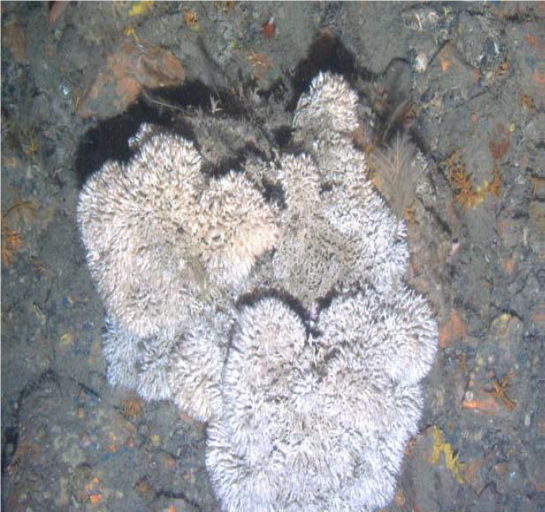Cold-water corals (Figure 1) found in deep waters, such as the Darwin Mounds to the north-east of Rockall and the Mingulay reef complex in the Sea of the Hebrides (both Rockall Offshore Marine Region) may be particularly sensitive to decreases in pH and CO32- (Findlay et al., 2013). These coral colonies serve as shelter, feeding and breeding habitats for fish.
The Mingulay reef complex is subjected to a tidal downwelling caused by internal waves. This downwelling, which brings surface waters down to >100 m, results in a decrease in bottom water nutrient concentrations by ~21% and salinity by ~0.21. Total alkalinity (TA) was found to be uniform through the water column with only a slight change as a consequence of the tidal cycle. The tidal downwelling brought low concentration dissolved inorganic carbon (DIC) surface waters to the reef surface resulting in pH increasing 0.1 pH units. Aragonite saturation showed a similar pattern increasing from < 2.1 to ~2.3 but remaining supersaturated throughout.
The natural variability in pH at the site highlights the importance of understanding the natural processes that marine ecosystems can experience on a local scale. While cold water corals at Mingulay are subject to downwelling events, which may protect skeleton integrity, corals in deeper waters may be exposed to upwelling events bringing high concentration DIC, low pH, low aragonite waters to the reef. Such potential upwelling events may exacerbate impacts under future predicted ocean acidification (OA) scenarios (see Climate change Ocean acidification).

Figure 1: Lophelia pertusa coral from the East Mingulay site in good condition.
Marine ecosystems are adapted to their physical and chemical environment. Any changes in the physical characteristics of the marine environment can influence marine life and sustainable use of the seas. It is therefore important to understand changes in these physical and chemical characteristics in assessing whether we are working towards Scotland’s vision for clean, healthy, safe, productive, biologically diverse marine coastal environments, managed to meet the long-term needs of nature and people.
This assessment of physical and chemical characteristics covers, circulation, sea level, waves, temperature and salinity, as well as stratification and water clarity (turbidity).
The oceans are absorbing much of the carbon dioxide and excess heat resulting from a changing global climate. This absorption results in ocean acidification and increasing temperatures contribute to a loss of oxygen from the sea. These processes may have an adverse impact on marine life, and therefore the latest information on ocean acidification and dissolved oxygen (one of the Clean and safe Eutrophication assessments) are also presented.
The five case studies demonstrate some applications related to these assessments. These include a review of Scotland’s tidal stream resource, an example of dissolved oxygen measurements using novel technologies, and three illustrations of variability of ocean acidification and marine organisms (two species of calcifying plankton, coccolithophores and pelagic gastropods at Stonehaven, and one species of cold-water coral).
The Physical characteristics and ocean acidification assessment in Scotland’s Marine Atlas 2011 can be found on the Scottish Government web archive here.

Links and resources
|
, 2013. Tidal downwelling and implications for the carbon biogeochemistry of cold-water corals in relation to future ocean acidification and warming. Global Change Biology, 19(9), pp.2708-2719. Available at: https://onlinelibrary.wiley.com/doi/abs/10.1111/gcb.12256. |

